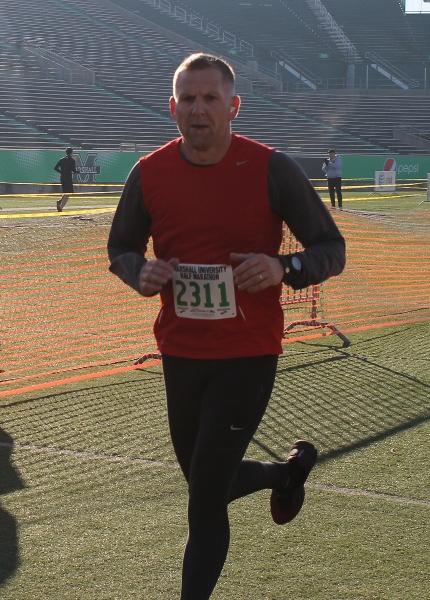Have you ever been in a rut, not improving and running slower than you used to?
It’s a difficult situation. You want to desperately improve and feel better on your training runs but you’re not sure what to do. Some runners don’t do anything and stay in a holding pattern for months. Their fitness plateaus, their race times stagnate, and they start to feel like crap all the time. Nobody wants that.
As a Strength Runner, you know that the first rule of the Strength Running Vision is to be proactive – to take action and control over your running. You have the power to transform your training – sometimes you just need some guidance.
Making the Decision to Be a Better Runner
That’s exactly what Sam did two months ago. He had just DNF’d (Did Not Finish) at the Charleston Distance Run, an historic 15 mile race in West Virginia. He ran 1:42 twice about 15 years ago and 1:58 last year. This year, he didn’t even finish and battled a persistent case of plantar fasciitis.
“After the DNF at the CDR I was frustrated,” Sam recalled. “I knew I over-trained and simply ran improperly for me. I found Strength Running and read a lot of posts. I really loved the SR message and decided a Plateau Buster was exactly what I needed. I wanted to get back on track to not only run faster but to make running more enjoyable for me.”
Sam bought a Plateau Buster, a personalized training critique to see what he could improve. With a half-marathon coming up in 7 short weeks, he needed as much help as he could get to avoid another DNF. His goals were simple: train smart, run more on feel, stop putting so much pressure on himself, and run a successful half.
Looking at his detailed answers in the Runner Questionnaire, I recognized several key areas that Sam could improve upon. His training was good – but it could be better. I could see that he was running too hard, too frequently. It affected his workouts for days after his overzealous training efforts.
Sam also needed adjustments to his strength workouts. With a more runner-specific core and lifting program, he’s better able to prevent injuries and stay healthy.
I also changed how he structured his mileage, with more emphasis on his long run and a slight bump in overall volume. His workouts were updated to more closely mimic the demands of his upcoming race. Now, Sam was training with new purpose for his half-marathon.
“I started using the key workouts that were prescribed for me in the Plateau Buster. I became much more comfortable with my running and felt a lot better, very quickly,” Sam said of his new training program.
Because of his history and schedule, I recommended that he run mostly by feel and not to put too much pressure on himself to hit certain times in his distance runs. It worked. “I always ran the long runs totally on feel, forgetting the watch and only checking it at the finish.”
Sam Runs an Age Group Finish
So, how did Sam run?
“Very well! After I bought into what the Strength Running philosophy, I bought the Plateau Buster, which was a no brainer – boy was I right!” Sam said. After last year’s 1:58 in a 15 miler (equivalent to about 1:44 in a half-marathon) and this year’s DNF, he wanted a serious improvement: his goal was to run under 1:40 for the half-marathon. Well, Sam ended up running 1:37:26 – close to his PR from years ago.
“I feel like I am on my way back to being a low 1:30 (or dare I say, better) half-marathoner. I even amazed myself at how much I improved in just 7 weeks.” His 1:37 half-marathon time was good enough for a 2nd place age-group finish for a Master’s Male.
“The top 3 positive results from getting the Plateau Buster are being injury-free, running faster and having a lot more fun in my training. The difference in the way I trained before the Plateau Buster was significant. Before I was way too dependent on pace and my pre-run warm-up was not enough. These days I’m feeling great.”
Sam also started doing something he never did before (or even consider doing): he keeps an accurate training log. He writes down basic information like distance, time, pace, type of workout, weather, split times, and how he felt before and during the workout.
“I really found this log important – it’s useful for future training and really helpful to see what I had done and how I felt about certain workouts. It turned out to be a great motivator and teaching tool.”
What’s Next?
Sam embodies what it means to take control over your running. He made a choice to take action and now he’s reaping rewards that last for months: better fitness, more confidence, and the simple pleasure of enjoying his running more than ever.
Sam hopes to prolong the success he’s having through the winter months. “I hope to get more help next spring to get even faster, with a possible sub-1:30 half-marathon in 2012! I think it’s possible – now I’m faster, happier, and feel physically better. Would I recommend a Plateau Buster to another runner? Yes, yes, yes!”
Hearing about this incredible success story is amazing – thank you Sam for sharing it with us! Here’s to another successful year of great training and races.
Click here to learn more about the Plateau Buster and other types of coaching I offer runners to help them reach their goals.